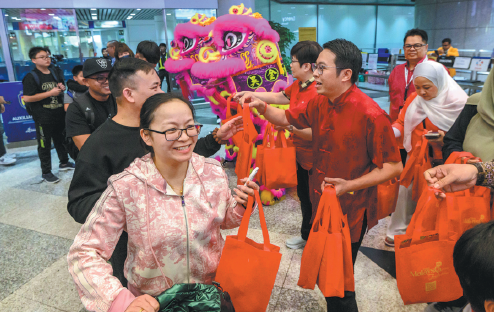Malaysia proving to be a hot tourist draw card
Relaxation of visa rules has helped spur much greater demand, Yang Feiyue reports.

For culture enthusiasts, island lovers, luxury shoppers and families from China, touring Malaysia opens up many options, and more are to come.
Malaysia has adopted a plan to attract 7 million Chinese tourists annually by 2026, capitalizing on the explosive growth spurred by its visa-free policy and diverse tours for Chinese citizens.
Malaysia expects the plan to contribute significantly to its overall goal of 35.6 million international visitors, says Aaron Gan Chai Heng, director of the Tourism Malaysia Shanghai.
To achieve this target, Malaysia will increase the number of direct flights connecting various Chinese cities and make the most of the popular travel route connecting Malaysia, Singapore and Thailand to boost multi-destination tourism, Gan says.
"For this year, there is definitely a plan to increase direct flights, but these are subject to talks between the airlines and the airport authorities of Malaysia and China."
In addition, seasonal chartered flights from second-tier cities to a few new destinations on the east coast of Peninsular Malaysia are being discussed, apart from the normal charter flights to destinations such as Semporna and Langkawi.
Malaysia will also conduct more targeted marketing campaigns in China to promote its attractions and work with major Chinese online travel agencies to offer exclusive packages, he says.
China and Malaysia agreed to extend mutual visa-free policy last year. China has extended the facility until the end of this year, and Malaysia will extend the visa exemption for Chinese travelers until the end of next year, according to a joint statement by the two countries.
The mutual visa exemption policy has been in place since December 2023, and the Malaysian tourism market has had a big influx of Chinese tourists.
Malaysia's Minister of Transport, Loke Siew Fook, says that in the first year of the visa-free policy, about 4 million Chinese tourists visited Malaysia. Malaysia could serve as a gateway for Chinese tourists traveling to Indonesia, Singapore and Thailand, he says.
The visa-free policy implemented in December 2023 has significantly boosted arrivals, with a 190 percent increase in Chinese tourists by mid-2024 compared with the previous year, Gan says.
"The introduction of a visa-free policy as well as auto-gate entry upon arrival at Kuala Lumpur International Airport for Chinese nationals has been a major factor in this resurgence," he says, adding that Chinese tourists are spending more, with average spending ranging from 5,000-6,000 yuan ($685-$820) per trip.
"This is higher than the average tourist spend, reflecting a trend toward more luxury and tailored experiences."
Malaysia has emerged as a top outbound destination for Chinese travelers, says Li Mengran, marketing manager of Utour, a travel agency in Beijing.
The country's visa-free policy has significantly boosted travel demand from China, giving rise to notable growth in the trip bookings, Li says.
"For culture enthusiasts, the country provides immersive heritage tours featuring Kuala Lumpur city sights as well as activities such as watching historical theater performances at Encore Melaka Theatre, riding vintage trams and exploring Peranakan culture through museum visits and traditional costume workshops."
Island getaways represent another major draw, with destinations such as Sipadan for diving and Redang Island, where the popular Chinese movie Summer Holiday, was filmed.
"The trend of island-hopping packages has taken off, offering stays at scenic resorts and a range of water activities from snorkeling to sea kayaking," Li says. "These picturesque locations, complete with overwater villas and pristine sandbars, have proved particularly appealing for social media-savvy younger Chinese travelers."
More than 80 percent of Utour customers who are under 40 have opted for visits to those island destinations, such as Sabah and Semporna, Li says.
Travel by families has flourished as well, with Legoland Malaysia Resort a big draw for parents and children, Li says.
"Malaysia's repeat-visit potential is huge. Many explore cities first, then return for islands."
To spice up travel for Chinese, more tailored visits are being prepared, including luxury shopping, cultural heritage tours and eco-friendly destinations, Gan says.
Mandarin-speaking services and Alipay and WeChat Pay will be made more widely available, he says.
"These strategies aim not only to increase the number of visitors but also enhance their overall experience and spending in Malaysia."
































